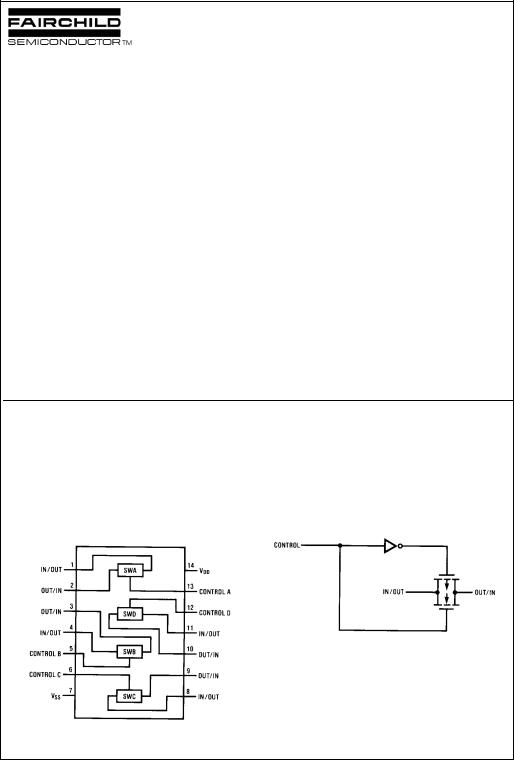Fairchild Semiconductor CD4016BCN, CD4016BCMX, CD4016BCM Datasheet

November 1983
Revised January 1999
CD4016BC
Quad Bilateral Switch
General Description
The CD4016BC is a quad bilateral switch intended for the transmission or multiplexing of analog or digital signals. It is pin-for-pin compatible with CD4066BC.
Features
■Wide supply voltage range: 3V to 15V
■Wide range of digital and analog switching: ±7.5 VPEAK
■“ON” resistance for 15V operation: 400Ω (typ.)
■Matched “ON” resistance over 15V signal input:
RON = 10Ω (typ.)
■High degree of linearity: 0.4% distortion (typ.)
@fIS = 1 kHz, VIS = 5 Vp-p, VDD−VSS = 10V, RL = 10 kΩ
■Extremely low “OFF” switch leakage: 0.1 nA (typ.)
@VDD − VSS = 10V
TA = 25°C
■Extremely high control input impedance: 1012Ω (typ.)
■Low crosstalk between switches:
−50 dB (typ.)
@fIS = 0.9 MHz, RL = 1 kΩ
■Frequency response, switch “ON”: 40 MHz (typ.)
Applications
•Analog signal switching/multiplexing Signal gating
Squelch control Chopper Modulator/Demodulator Commutating switch
•Digital signal switching/multiplexing
•CMOS logic implementation
•Analog-to-digital/digital-to-analog conversion
•Digital control of frequency, impedance, phase, and ana- log-signal gain
Ordering Code:
Order Number |
Package Number |
Package Description |
|
|
|
CD4016BCM |
M14A |
14-Lead Small Outline Integrated Circuit (SOIC), JEDEC MS-120, 0.150” Narrow |
|
|
|
CD4016BCN |
N14A |
14-Lead Plastic Dual-In-Line Package (PDIP), JEDEC MS-001, 0.300” Wide |
|
|
|
Devices also available in Tape and Reel. Specify by appending the letter suffix “X” to the ordering code.
Connection Diagram |
Schematic Diagram |
Pin Assignments for DIP and SOIC |
|
Switch Bilateral Quad CD4016BC
© 1999 Fairchild Semiconductor Corporation |
DS005661.prf |
www.fairchildsemi.com |

CD4016BC
Absolute Maximum Ratings(Note 1)
(Note 2) |
|
VDD Supply Voltage |
−0.5V to +18V |
VIN Input Voltage |
−0.5V to VDD + 0.5V |
TS Storage Temperature Range |
−65°C to + 150°C |
Power Dissipation (PD) |
|
Dual-In-Line |
700 mW |
Small Outline |
500 mW |
Lead Temperature |
|
(Soldering, 10 seconds) |
260°C |
DC Electrical Characteristics (Note 2)
Recommended Operating
Conditions (Note 2)
VDD Supply Voltage |
3V to 15V |
VIN Input Voltage |
0V to VDD |
TA Operating Temperature Range |
−40°C to +85°C |
Note 1: “Absolute Maximum Ratings” are those values beyond which the safety of the device cannot be guaranteed. They are not meant to imply that the devices should be operated at these limits. The tables of “Recommended Operating Conditions” and “Electrical Characteristics” provide conditions for actual device operation.
Note 2: VSS = 0V unless otherwise specified.
Symbol |
Parameter |
Conditions |
-40°C |
|
25°C |
|
+85°C |
Units |
||
|
|
|
|
|
|
|
||||
|
|
|
Min |
Max |
Min |
Typ |
Max |
Min |
Max |
|
|
|
|
|
|
|
|
|
|
|
|
IDD |
Quiescent Device |
VDD = 5V, VIN = VDD or VSS |
|
1.0 |
|
0.01 |
1.0 |
|
7.5 |
mA |
|
Current |
VDD = 10V, VIN = VDD or VSS |
|
2.0 |
|
0.01 |
2.0 |
|
15 |
mA |
|
|
VDD = 15V, VIN = VDD or VSS |
|
4.0 |
|
0.01 |
4.0 |
|
30 |
mA |
Signal Inputs and Outputs |
|
|
|
|
|
|
|
|
|
|
|
|
|
|
|
|
|
|
|
|
|
RON |
“ON” Resistance |
RL = 10kW to (VDD - VSS)/2 |
|
|
|
|
|
|
|
|
|
|
VC = VDD, VIS = VSS or VDD |
|
|
|
|
|
|
|
|
|
|
VDD = 10V |
|
610 |
|
275 |
660 |
|
840 |
W |
|
|
VDD = 15V |
|
370 |
|
200 |
400 |
|
520 |
W |
|
|
RL = 10kW to (VDD - VSS)/2 |
|
|
|
|
|
|
|
|
|
|
VC = VDD |
|
|
|
|
|
|
|
|
|
|
VDD = 10V, VIS = 4.75 to 5.25V |
|
1900 |
|
850 |
2000 |
|
2380 |
W |
|
|
VDD = 15V, VIS = 7.25 to 7.75V |
|
790 |
|
400 |
850 |
|
1080 |
W |
DRON |
D“ON” Resistance |
R L = 10kW to (VDD - VSS)/2 |
|
|
|
|
|
|
|
|
|
Between any 2 of |
VC = VDD, VIS = VSS to VDD |
|
|
|
|
|
|
|
|
|
4 Switches |
VDD = 10V |
|
|
|
15 |
|
|
|
W |
|
(In Same Package) |
VDD = 15V |
|
|
|
10 |
|
|
|
W |
IIS |
Input or Output |
VC = 0, VDD = 15V |
|
±50 |
|
±0.1 |
±50 |
|
±200 |
nA |
|
Leakage |
VIS = 0V or 15V, |
|
|
|
|
|
|
|
|
|
Switch “OFF” |
V OS = 15V or 0V |
|
|
|
|
|
|
|
|
Control Inputs |
|
|
|
|
|
|
|
|
|
|
|
|
|
|
|
|
|
|
|
|
|
VILC |
LOW Level Input |
VIS = VSS and VDD |
|
|
|
|
|
|
|
|
|
Voltage |
VOS = VDD and VSS |
|
|
|
|
|
|
|
|
|
|
IIS = ±10 mA |
|
|
|
|
|
|
|
|
|
|
VDD = 5V |
|
0.9 |
|
|
0.7 |
|
0.4 |
V |
|
|
VDD = 10V |
|
0.9 |
|
|
0.7 |
|
0.4 |
V |
|
|
VDD = 15V |
|
0.9 |
|
|
0.7 |
|
0.4 |
V |
VIHC |
HIGH Level Input |
VDD = 5V |
3.5 |
|
3.5 |
|
|
3.5 |
|
V |
|
Voltage |
VDD = 10V |
7.0 |
|
7.0 |
|
|
7.0 |
|
V |
|
|
VDD = 15V |
11.0 |
|
11.0 |
|
|
11.0 |
|
V |
|
|
(Note 3) and Figure 8 |
|
|
|
±10−5 |
|
|
|
|
IIN |
Input Current |
VCC - VSS = 15V |
|
±0.3 |
|
±0.3 |
|
±1.0 |
mA |
|
|
|
VDD ³ VIS ³ VSS |
|
|
|
|
|
|
|
|
|
|
VDD ³ VC ³ VSS |
|
|
|
|
|
|
|
|
Note 3: If the switch input is held at VDD, VIHC is the control input level that will cause the switch output to meet the standard “B” series V OH and IOH output levels. If the analog switch input is connected to VSS, VIHC is the control input level — which allows the switch to sink standard “B” series |I OH|, high level current, and still maintain a VOL ≤ “B” series. These currents are shown in Figure 8.
www.fairchildsemi.com |
2 |

AC Electrical Characteristics (Note 4)
TA = 25°C, tr = tf = 20 ns and VSS = 0V unless otherwise specified
Symbol |
Parameter |
Conditions |
Min |
Typ |
Max |
Units |
|
|
|
|
|
|
|
tPHL, tPLH |
Propagation Delay Time |
VC = VDD, CL = 50 pF, (Figure 1) |
|
|
|
|
|
Signal Input to Signal Output |
RL = 200k |
|
|
|
|
|
|
VDD = 5V |
|
58 |
100 |
ns |
|
|
VDD= 10V |
|
27 |
50 |
ns |
|
|
VDD = 15V |
|
20 |
40 |
ns |
tPZH, tPZL |
Propagation Delay Time |
RL = 1.0 kΩ, CL = 50 pF, (Figure 2, Figure 3) |
|
|
|
|
|
Control Input to Signal |
VDD = 5V |
|
20 |
50 |
ns |
|
Output HIGH Impedance to |
VDD = 10V |
|
18 |
40 |
ns |
|
Logical Level |
VDD = 15V |
|
17 |
35 |
ns |
tPHZ, tPLZ |
Propagation Delay Time |
RL = 1.0 kΩ, CL = 50 pF, (Figure 2, Figure 3) |
|
|
|
|
|
Control Input to Signal |
VDD = 5V |
|
15 |
40 |
ns |
|
Output Logical Level to |
VDD = 10V |
|
11 |
25 |
ns |
|
HIGH Impedance |
VDD = 15V |
|
10 |
22 |
ns |
|
Sine Wave Distortion |
VC = VDD = 5V, VSS = −5 |
|
0.4 |
|
% |
|
|
RL = 10 kΩ, VIS = 5 VP-P, f = 1 kHz, |
|
|
|
|
|
|
(Figure 4) |
|
|
|
|
|
|
|
|
|
|
|
|
Frequency Response — Switch |
V C = VDD = 5V, VSS = −5V, |
|
40 |
|
MHz |
|
“ON” (Frequency at −3 dB) |
RL = 1 kΩ, VIS = 5 VP-P, |
|
|
|
|
|
|
20 Log10 VOS/VOS (1 kHz) −dB, |
|
|
|
|
|
|
(Figure 4) |
|
|
|
|
|
Feedthrough — Switch “OFF” |
V DD = 5V, VC = VSS = −5V, |
|
1.25 |
|
MHz |
|
(Frequency at −50 dB) |
RL = 1 kΩ, VIS = 5 VP-P, |
|
|
|
|
|
|
20 Log10 (VOS/VIS) = −50 dB, |
|
|
|
|
|
|
(Figure 4) |
|
|
|
|
|
Crosstalk Between Any Two |
VDD = VC(A) = 5V; VSS = VC(B) = −5V, |
|
0.9 |
|
MHz |
|
Switches (Frequency at −50 dB) |
RL = 1 kΩVIS(A) = 5 VP-P, |
|
|
|
|
|
|
20 Log10 (VOS(B)/VOS(A) ) = −50 dB, |
|
|
|
|
|
|
(Figure 5) |
|
|
|
|
|
Crosstalk; Control Input to |
VDD = 10V, RL = 10 kΩ |
|
150 |
|
mVP-P |
|
Signal Output |
RIN = 1 kΩ, VCC = 10V Square Wave, |
|
|
|
|
|
|
CL = 50 pF (Figure 6) |
|
|
|
|
|
Maximum Control Input |
RL = 1 kΩ, CL = 50 pF, (Figure 7) |
|
|
|
|
|
|
VOS(f) = ½ V OS(1 kHz) |
|
|
|
|
|
|
VDD = 5V |
|
6.5 |
|
MHz |
|
|
VDD = 10V |
|
8.0 |
|
MHz |
|
|
VDD = 15V |
|
9.0 |
|
MHz |
CIS |
Signal Input Capacitance |
|
|
4 |
|
pF |
COS |
Signal Output Capacitance |
VDD = 10V |
|
4 |
|
pF |
CIOS |
Feedthrough Capacitance |
VC = 0V |
|
0.2 |
|
pF |
CIN |
Control Input Capacitance |
|
|
5 |
7.5 |
pF |
Note 4: AC Parameters are guaranteed by DC correlated testing.
Note 5: These devices should not be connected to circuits with the power “ON”.
Note 6: In all cases, there is approximately 5 pF of probe and jig capacitance on the output; however, this capacitance is included in CL wherever it is specified.
Note 7: VIS is the voltage at the in/out pin and VOS is the voltage at the out/in pin. VC is the voltage at the control input.
CD4016BC
3 |
www.fairchildsemi.com |
